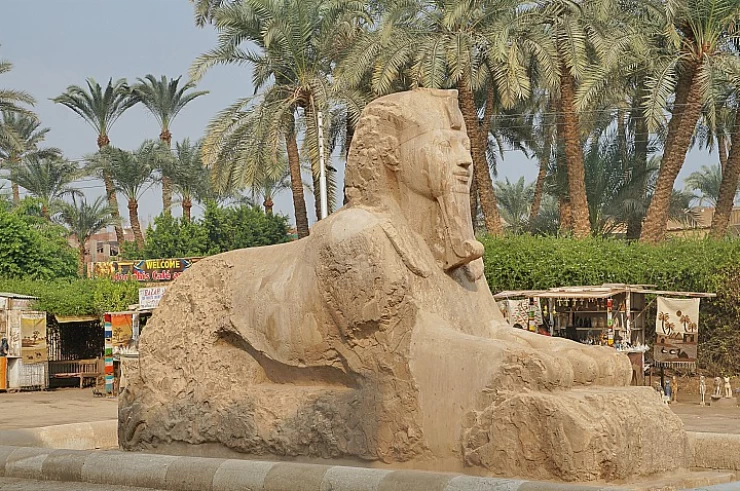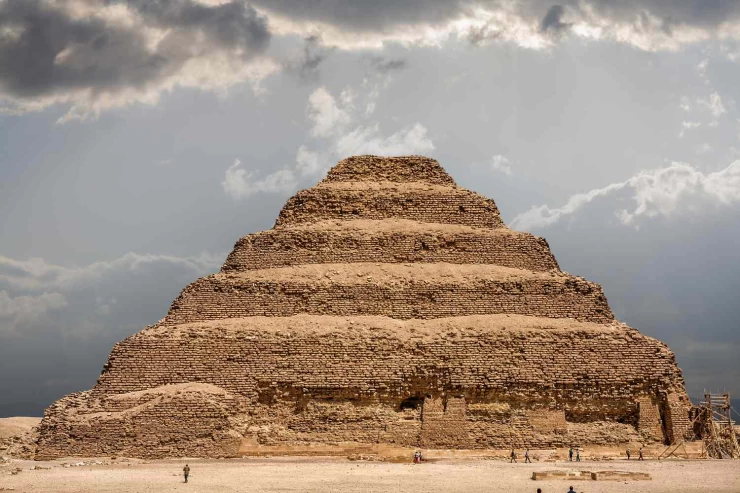
Pyramides d'Egypte | Pyramides d'Egypte
Les pyramides d'Égypte sont d'anciennes structures égyptiennes en forme de pyramides. Depuis novembre 2008, des sources estiment que le nombre de pyramides égyptiennes est d'environ 118 ou 138. Durant l'Antiquité et le Moyen Âge, la majorité d'entre elles ont été construites comme tombes pour les anciens pharaons et leurs dépendants.
Les plus anciennes pyramides égyptiennes connues se trouvent à Saqqarah, au nord-ouest de Memphis. La plus ancienne de ces pyramides est la pyramide à degrés du roi Djoser, qui a été construite de 2630 à 2610 avant JC sous la troisième dynastie. Créée par l'architecte Imhotep, cette pyramide et la collection environnante sont généralement considérées comme les plus anciennes structures massives au monde construites à partir de travaux de construction.
Parmi les pyramides égyptiennes les plus célèbres se trouvent celles du gouvernorat de Gizeh, à la périphérie du Caire. La plupart des pyramides de Gizeh comptent parmi les plus grandes structures jamais construites au monde. La pyramide de Khéops à Gizeh est la plus grande pyramide égyptienne. C'est la seule des sept merveilles du monde antique encore en existence.
L'une des sept merveilles du monde restant jusqu'à présent faite par l'homme et jusqu'à présent, nous avons beaucoup d'opinions différentes pour les scientifiques et les chercheurs sur ce qu'est la pyramide et comment la construire. Mais si nous regardons en arrière et voyons la première pyramide, le pas pyramide et suivi les théories et leurs traces, nous connaîtrons beaucoup de secrets et comment construire ce grand édifice.
La deuxième pyramide égyptienne historiquement documentée est attribuée à l'architecte Imhotep, qui a planifié ce que les égyptologues pensent être un tombeau pour le pharaon Djoser. On attribue à Imhotep le fait d'être le premier à concevoir la notion d'empilement des mastabas les uns sur les autres, créant un édifice composé d'un certain nombre de "marches" dont la taille a diminué vers son sommet.
Le résultat a été la construction de la pyramide de Djoser, qui a été conçue pour être un escalier géant à travers lequel l'âme du pharaon décédé pouvait monter au ciel, et c'était son plan pour atteindre son but, que les défunts Egyptiens ont déifié après lui.
Longtemps après la fin de la période de construction des pyramides en Égypte, une explosion de construction de pyramides s'est produite dans ce qui est aujourd'hui le Soudan. Après qu'une grande partie de l'Égypte soit tombée sous le règne du royaume de Kush, alors basé à Napata.
Alors que la domination napatéenne était brève, se terminant en 661 avant JC, la culture égyptienne a fait une impression indélébile. La période méroïtique de l'histoire de Kushite, lorsque le royaume était centré sur Meroë, (environ entre 300 avant notre ère et 300 avant notre ère), a vu un renouveau complet de la construction de pyramides, qui a vu plus de deux cents pyramides royales indigènes d'inspiration égyptienne. Tombes construites à proximité des capitales du royaume.
On pense que la forme des pyramides égyptiennes représente la colline primitive dans laquelle les Egyptiens croyaient que la terre avait été créée et que la forme de la pyramide représenterait la lumière du soleil descendante loin.
Les pyramides étaient souvent également nommées d'une manière qui faisait référence à la luminescence solaire. Par exemple, le nom officiel de la pyramide pliée à Dahchour était la pyramide brillante du sud et celui de Senwosret à el-Lahun était Senwosret est brillant.
En 1842, Carl Richard Lipsius a publié la première liste moderne de pyramides - maintenant connue sous le nom de «Liste des pyramides de Lipsius», qui comptait le nombre de pyramides à 67 pyramides, et un autre grand nombre a été découvert depuis lors, à partir de novembre 2008 , 118 nombre de pyramides égyptiennes ont été déterminés. La pyramide la plus récente à découvrir est celle de Sesheshet à Saqqarah, mère du pharaon Teti de la sixième dynastie, annoncée le 11 novembre 2008.
Toutes les pyramides d'Égypte, à l'exception de la petite pyramide de la troisième dynastie, se trouvent dans le coin des morts (ou le coin des morts), sur la rive Ouest du Nil, et la plupart d'entre eux sont regroupés dans un certain nombre de champs pyramidaux. Les plus célèbres d'entre eux sont répertoriés géographiquement, du nord au sud, ci-dessous.
- Abu Rawash
- Gizeh
- Zawyet el-Aryan
- Abusir
- Saqqarah
- Dahshur
- Mazghuna
- Lisht
- Meidum
- Hawara
- el-Lahun
- El-Kurru
- Nuri
Les pyramides de Gizeh sont appelées la nécropole de Gizeh. Le complexe des pyramides de Gizeh est situé dans un site archéologique sur le plateau de Gizeh, dans le Grand Caire, en Égypte. Le complexe contient la Grande Pyramide, la Pyramide de Khafre et la Pyramide de Menkaure, ainsi que leurs complexes pyramidaux associés et le Sphinx. Ces pyramides ont toutes été construites pendant la quatrième dynastie de l'Ancien Empire de l'Égypte ancienne, entre 2600 et 2500 av. Le site contient également plusieurs tombes et les vestiges d'un village d'ouvriers. Les pyramides s'étendent également d'Abou Rawash, à Gizeh, à Hawara, dans la banlieue de Fayoum. Ce sont des édifices royaux et archéologiques construits par les anciens Égyptiens dans la période 2630 av. Et jusqu'à l'an 1530 av. M. Sa construction a été progressive, de la première pyramide à degrés établie comme la pyramide de Djoser (3630 av. J.-C. - 2611 av. J.-C.) à Saqqara à une pyramide inclinée puis à la forme pyramidale complète bien connue représentée par les pyramides de Gizeh. Les pyramides ont été construites selon la croyance des anciens Égyptiens afin de préserver la momie du pharaon et de l'aider dans son voyage vers l'au-delà et son ascension au ciel. Le roi Khufu a également construit la grande pyramide pour l'y enterrer. Les anciens Égyptiens croyaient que l'esprit du roi continuerait à prendre soin d'eux même après leur mort, puis qu'il monterait au ciel et rejoindrait le reste des dieux. Il pourrait alors nourrir les vivants sur terre en leur envoyant la crue du Nil, la croissance et la prospérité, et les empêcher de faire le mal.
Des circuits en Egypte remarquables et sûrs ! Avec nos circuits de Pâques en Égypte 2023, vous ressentirez la grâce de l'esprit antique des Égyptiens en explorant les majestueuses pyramides, les temples, les tombeaux qui hantent votre esprit et votre âme tout en bénéficiant du meilleur service. Des meilleures croisières sur le Nil aux forfaits classiques de visites de sites historiques, Cairo Top Tours propose une gamme d'activités et de vacances d'aventure en Égypte. Outre les sites historiques traditionnels, nous proposons une sélection distinctive de safaris dans le désert égyptien à travers le silence magique et l'attrait des Oasis de Siwa, dans le désert égyptien. Choisissez parmi les meilleures offres d'excursions d'une journée en Égypte et choisissez l'une de nos superbes excursions d'une journée au Caire. Nos passionnantes excursions à Louxor et excursions à Assouan vous feront découvrir tous les chefs-d'œuvre historiques de la ville. Notamment la fascinante Vallée des Rois, le fantastique temple de la reine Hatchepsout et les temples uniques d'Abu Simble, le tout accompagné d'un guide expert qui vous expliquera l'histoire de ces incroyables sites. Nos experts vous viendrons en aide, a partir des aéroports de l' Egypte et partout où besoin sera demandé.
Positioned at an elevation surrounded by sand hills, one can easily understand why the pyramids found in Egypt are one of the most recognizable structures quite literally in the whole world. It is perhaps impossible to get a person who has traveled, read, or even watched a documentary and not be captivated by these towering structures that have stood the test of time for centuries. Their beauty and how they were constructed leave no one indifferent and is the primary reason historians, regardless of age, travel to ancient countries. With that being said, let us go back in time to study the greatness of the pyramids in Egypt, why they matter historically, and what impact, if any, they made for future generations.
A Glimpse into Ancient Egypt’s Architectural Genius
From a historical perspective, the magnificence of the pyramids reveals the creativity and architectural skills of the ancient Egyptians. These great edifices, built as shrines for the kings and emperors to symbolize their godly power, display the heightened level of engineering, mathematics, and astronomy acquired by the Egyptians.
These pyramids were not simply built to contain and protect the preserved corpses of kings and queens. They were designed along the lines of doorways or rather turned off to be concerned with the interior, the beyond. The ancients believed that their kings would not only reign over them in this world but also in the next, and so the pyramids were constructed to provide fit accommodations for their wandering spirits. So too with the physical body of the pharaoh, riches, provisions, and ritual items were interred to assist the person’s transition to everlasting life.
The Great Pyramid of Khufu
Due to several centuries of exposure, the pyramid stands at only about 138 m in height, which is still considerable.
The Great Pyramid is estimated to have contained more than 2.3 million stone blocks, with several characters feasible weighing one hundred tons, and considering this, it could be said that the pyramid strategies are among the engineering marvels of the ancient world. Even how the Egyptians would have managed to cut, transport, and assemble the huge blocks remains a mystery—some say that ramps or even cranes had been employed, yet others say that only brute strength sufficed; others propose the use of intellect.
The Pyramid of Khafre
Khafre’s Pyramid, also known as the tomb of Khafre the Son of Pharaoh Khufu, is one of the many structures situated in the Giza plateau region. Even though Khafre's pyramid is shorter than his father's, he seems to dwarf his father’s pyramid because of its placement on higher ground and, more importantly, a large part of the upper part of the pyramid, which has the original smooth casing stones that have survived the weather elements, giving the impression of a much bigger structure. All the pyramids had this layer, made of glossy Tura limestone that was so well polished it was almost glass; hence all of them glittered in the sun.
In addition, the Pyramid of Khafre features the Great Sphinx of Giza, found at the front of the pyramid. The Great Sphinx, which possesses the head of a man and the body of a lion, is carved from a singular piece of limestone and is largely assumed to symbolize Khafre. This giant figure, which is positioned at the front of the pyramids, piques curiosity towards the Giza complex even more.
The Pyramid of Menkaure
Out of the three pyramids in Giza, the smallest is undoubtedly the Pyramid of Menkaure, erected for Khafre’s son, Pharaoh Menkaure. However, this pyramid stands out because part of its casing is made of granite instead of the common limestone used for most well-known pyramids. This material, coupled with the pitch and height of the pyramid, suggests that Menkaure had ambitions of being remembered with the other great kings of Egypt.
Although the Pyramids of Giza are perhaps the most well-known, they are by no means the only pyramids in Egypt. Pyramids were built throughout the Nile Valley at various stages of Egyptian history and in different architectural styles, as well as for different purposes.
The Pyramid of Djoser
The Pyramid of Djoser is considered to be one of the oldest pyramids ever made and can be located in the Saqqara region with its necropolis. This step-designed tomb was built for Pharaoh Djoser by his architect Imhotep, who is mostly regarded as one of the creators of all pyramids to come. Rather than a smooth-sided infinite tower, Djoser’s pyramid is made of six terraced levels with an interesting layered look. This was a great milestone in the age of building pyramids, and it is still one of the most frequent places in Egypt.
The Bent Pyramid and the Red Pyramid
Another well-known location for pyramids is Dahshur, which features the Bent and Red Pyramids, both constructed by Pharaoh Sneferu. The Bent Pyramid stands out due to its unique design since the angles of the sides bend in the middle of the pyramid. This shaped more than a simple pyramid, and it was probably because of some problems encountered while building the pyramid. Nevertheless, it was not much later that Sneferu attempted to build his second pyramid, now called the Red Pyramid, and this one was much more successful than the first, for it became the first true pyramidal structure on a smooth surface within the territory of Egypt.
The massive blocks were maneuvered using ramps, sleds, and some levers. But there are other theories regarding the construction of the great pyramids that are more advanced than this; for instance, aliens coming to earth and building the pyramids, but so-called ‘crazy’ theories are generally not accepted by scholars.
There have been new studies that have come up with such things as the discovery of the workers’ villages and the tools, which also assist in helping people understand the construction of the great pyramids much more than before. Evidence goes against the perception of slavery, for it appears that pyramid builders were given food and shelter, and their work was appreciated.
The geometric understanding of a pyramid, characterized by a wider base that tapers to a point at the top, was designed to represent the rays emitted by the sun as the dead pharaoh was believed to rise and join the sun god, Ra, in death. The position of the pyramids north and south of the equator as well as their alignment with the constellations embodies the Egyptians’ firm belief in the connection between the sky and the land of the living.
Inside the pyramids, spaces, and corridors were typically built with the purpose of housing the pharaoh’s body while also serving as a means to help the spirit cross over. The insides of many pyramids were embellished with inscriptions called Pyramid Texts that consisted of spells for helping the hereafter of the pharaoh. Even though most of the valuables and objects that were kept in these pyramids have been taken away or destroyed over the years, the pyramids themselves are forever embodiments of the Egyptian faith of existence after death.
The Legacy of the Pyramids
The pyramids of Egypt have had a lasting impact on the course of history, in as much as they can be compared to any other structure. The dimensions of the pyramids, their architectural intricacy, together with the enigma surrounding the periods of their construction have motivated several generations of humankind. In the present, those structures attract awe to innumerable people every year who want to see with their own eyes one of the most magnificent monuments created in ancient history.
Besides the appreciation of the pyramids as significant cultural and historical treasures, these structures have also become icons of human determination and creativity. Their position on the skyline of the desert of Egypt evokes memories of a culture that, many millennia ago, was capable of creating marvels that still amaze people today.


















